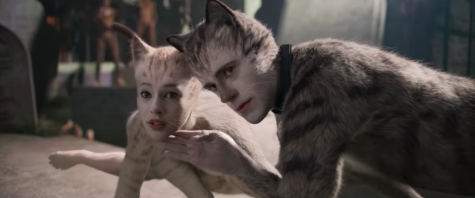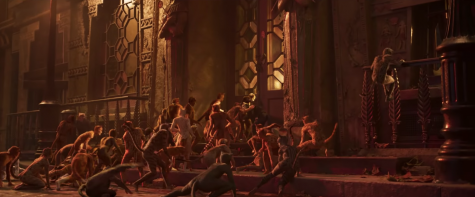Cats: not as much of a cat-astrophe as expected (but still pretty bad)
February 2, 2020
When the “Cats” movie trailer came out in mid-July, the internet was hit with a spectrum of reactions ranging from mild uneasiness to full-on, vomit-inducing antipathy. The less-than-spectacular box office results (around $6.5 million in the opening weekend for a $100 million budget) reflect a movie that miserably fails to emulate the magic of its Broadway predecessor, but it’s also not quite the horrifying nightmare that many thought it would be.
For those unfamiliar with the plot of “Cats,” the storyline follows a group of, well, cats, who are called Jellicles. They try to decide which Jellicle cat will ascend to the Heaviside Layer, meaning that they will be reborn in a new Jellicle life (yes, they really do love saying, “Jellicle”). Essentially, it’s a bunch of cats singing about how great they are.

Now, for what everyone’s wondering about: the animation. In all honesty, it wasn’t that bad. I say that with italics because it was bad—just not as cataclysmically bad as the trailer made it out to be. The digital fur technology that covers the actors in the movie is similar to the skinsuits typical of the Broadway production, so throughout the movie, it doesn’t have too large of an impact.
The real issues come in the hands, feet and faces, where the now-realistic feline bodies clash in a discordant blend of inconsistently furry patches of skin. Adding in the juxtaposition of some characters’ flat, hairless heads and, inexplicably, sneakers, it’s a far cry from the charming, if … interesting, costumes of the original musical production.
But aside from the characters themselves, a lot of the animation is just awful: The background often looks like a 3-D model on a fifth grader’s computer, and the actors’ feet seem to be constantly dipping into the distorted floor. And as more and more increasingly small human-beast rats and bugs begin to pop up, the CGI gets worse and worse.
With past musical renditions, critics of the “Cats” have talked about how there is no plot involved, which is probably why the movie adaption tried to add one in by mixing in dialogue and filler scenes to tie things together. The result, though, was some murky middle ground that alienated the musical’s fans while really adding nothing new to a broader audience, as the plot still made little sense. The key tactic used came in the form of more character development.
In some cases, this did add a bit more depth of reality to the movie. Take Mr. Mistoffeles, the magician cat, who is dramatized as he goes from a shy, insecure character to the hero who saves Old Deuteronomy (the cat in charge of the whole Heavyside layer procession) from death. In the stage musical, contrastingly, he seems to be a fully confident character from the get-go. In most any other cases, however, the changes detract from the plot. For example, the movie tries to make sense of the villain, Macavity, by adding in a new storyline where he magically appears in random times to kidnap characters. While the attempt tries to fill a plot hole in the musical, it seems half-baked and unhelpful, leaving perhaps more confusion in its wake—especially with the added dimension of magic it contributes. Grizabella also suffers from weaker character development, as the movie focuses far too much on expressing downcast despair; the musical version, however, shows a greater variety of emotions, like the wistful tone of nostalgia for her long-gone days of stardom. In the end, this prevents the audience from feeling the same pull toward Grizabella’s success in the end, instead wishing for other characters to be lifted into the Heavyside Layer.
As a movie rendition of a musical, music also plays a key role in the film, and it’s pretty good, in general. There is, as expected, a mix between the more traditional musical tones of, say, Robert Fairchild, and the pop sounds of celebrities like Jason Derulo, but the result does not detract too much from the enjoyment. Jennifer Hudson’s performance of the tear-jerker “Memory” is spectacular: It omits the tawdry technological tricks of the film’s animation, relying instead on raw emotion and impeccable acting that, for a moment, makes you forget the fact that her fur-covered face is a meme.
Similarly, dance is an important part of the film, intertwined within the scenes and songs. The casting of Royal Ballet Principal Dancers Francesca Hayward and Steven McRae as Victoria and Skimbleshanks, respectively, as well as ex–New York City Ballet Principal Dancer Robert Fairchild as Munkustrap, adds gorgeous movement to the movie. Concurrently, though, many of the pop-stars and actors without a traditional dance background can’t perform at such a level, leaving something missing in their solos. And although there are still enough fouettés, jetés and flips to go around, the dancing is often cut short by rapid changes in camera angle and focus; the viewers can never see the full beauty and lines of

the dancers—only flashes of brilliance that are stitched together by strands. For something so central to the musical, the dances often leave the audience waiting for a full scene that they never get, not because of anything the dancers themselves do but because of the director’s choices.
So is it worth a watch? Well, maybe. In many aspects, “Cats” tries to find an in-between to stay true to the musical while appealing to a broader audience of moviegoers. But what came out of the mixing machine was something in the middle that really failed to appeal to either. For the musical-lovers, “Cats” makes so many compromises that it feels a bit like a betrayal to the original. For the average movie-goer, these changes don’t really add anything to make it more accessible, and it’s underwhelming nonetheless.
I mean it could be worse: Imagine a Peppa Pig live action. But then again, that’s a low bar to beat.



